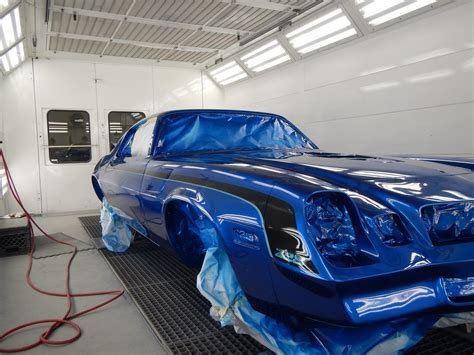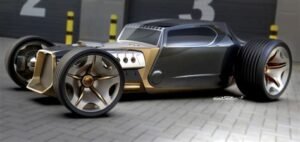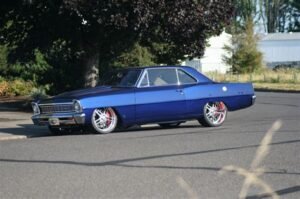
Classic car paint is more than just a skin-deep layer of color; it’s part of the identity and value of the car. A great paint job can take that tired old classic and turn it into a showstopper, while a poor paint job will detract from even the best restoration. In this, everything will be discussed, from restoration techniques to modern paint options in classic car painting. We go into great detail on color matching, surface preparation, and application methods to help you understand what goes into a successful paint job and how to choose the best option for your classic car.
Understanding the Importance of Classic Car Paint
Car paint serves many purposes other than serving an aesthetic one. The three basic roles of paints are protection, aesthetics, and investment.
Protection:
The paint forms a shield that protects the metal underneath from the environment, rust, and corrosion.
Aesthetics:
Much importance is given to the color and finish that the paint lends to the outlook of the car and, therefore, its value.
Historical accuracy is usually the first order for every car enthusiast, who wishes to restore the car into its specifications at the factory. As such, matching the original paint color and finish acquires greater importance in the process.
Consequently, much significance needs to be attached to the choice of paint and approach on its restoration or re-finishing while working on a classic car.
Restoring a Classic Car Paint Job
Classic car painting restoration is an art that involves a number of well-focused steps towards returning the car to its former glory. This may include:
1. Assessment and Planning
First, thoroughly inspect the condition of the paint. You are going to look for scratches, dents, rust, or even faded paint. Having grasped what already exists, you can now devise a means through which you will restore your car.
Considerations Toward Restoration Planning
Extent of Damage: The damage is superficial or extensive enough to involve much bodywork?
Original Paint: What type of paint was applied originally? Was it single-stage or multi-stage?
Your Budget: Classic car paint restoration is indeed expensive. So, you must have a budget and stick to it.
2. Surface Preparation
Good surface preparation is very critical for any successful paint job. This includes:
Removing Old Paint: The usual process is to remove the old paint through sandblasting, media blasting, or chemical stripping.
Bodywork: Fill in dents, scratches, and other blemishes. The things involved may be panel replacement, application of a filler, and sanding.
Application of Primer Coat: Application of the primer coat provides a smooth uniform surface for the paint to adhere to. It also provides corrosion protection.
3. Paint Application
Now that the surface preparation is complete, the car is finally ready for paint. There are many different application options for paint, and the correct choice depends on desired finish and expertise required. Some of the most common options include:
Spray Painting: This is used in most professional restorations, as it produces a perfect, continuous finish.
Brush Painting: This is the more traditional method that requires much ability and patience. It should, therefore, be restricted to use in smaller areas or special effects.
Powder Coating: Durable, environmentally friendly option that offers an excellent scratch and chip resistance.
Choosing the Right Paint
Choice of paint depends on many factors:
Original Paint: In the case of a historically sensitive restoration, you will want to use paint type identical to the original.
Desired Finish: You want to get a finish that is either gloss, matte, or satin.
Durability: Some paints are more durable than others, especially in UV resistance and scratch resistance.
Colour Match: You will have to find a paint supplier who can correctly match the car’s original colour. It may need using a spectrophotometer that defines the formula.
Refinishing a Classic Car Paint Job
Refinishing a classic car paint job is less involved than restoration but still requires painstaking attention to detail. It focuses on enhancing the appearance of an existing paint job without taking it down to bare metal. Refinishing will usually include:
1. Surface Preparation
As in restoration, proper surface preparation is key to any successful refinish. This will include:
Cleaning involves heavy cleaning of the paint surface to eliminate dirt and grime, among other contaminants.
Sand with progressively finer grades of sandpaper to feather out imperfections. Common progressions include: coarse, medium, fine, extra fine, ultra-fine.
Smaller scratches or dents are first filled in with filler, then sanded down to a smooth finish.
Application of Primer: The application of primer depending on the extent of refinishing, for proper adhesion of topcoat.
2. Paint Application
After surface preparation, refinishing involves the application of new paint. Common ways of application include:
Spray Painting: It is the common method of refinishing for a smooth and consistent finish.
Brush Painting: This is used for smaller areas or for special effects. It requires more expertise and time than spraying.
Selecting the Proper Paint for Refinishing
You have several choices for refinishing:
Single-Stage Paint: Color and clear coat are integrated into one layer. Easy to apply, but it may not be as durable as a multi-stage system.
Multi-Stage Paint: Separate layers of color and clear coat provide a deeper, more durable finish. More complex to apply.
3. Polishing and Protection
When it has dried, one should also consider polishing the surface for an even smooth and glossy appearance. Through polishing, some of the defects may be removed and shine of the paint improved. There is finally the application of wax or sealant to protect the paint from elemental factors and fading.
Modern Paint Options for Classic Cars
Classic car owners have varieties in restoration and refinishing with the paint technologies that have so far advanced. Some of these developments include:
1. Waterborne Paints
Waterborne paints have lately become very much popular among classic car restorers. They use water as their main solvent instead of traditional solvent-based paint, an environmental concern. In fact, waterborne paints boast excellent adhesion, durability, and color depth.
2. High-Performance Clear Coats
However, modern clear coats are more UV-resistant, scratch-resistant, and chip-resistant, providing a durable, long-lasting sheen to keep your classic car looking its best.
3. Color Matching Technology
Color matching technology has become very refined in modern times. The use of spectrophotometers is able to accurately capture the original paint color and analyze it for a perfect match on your classic car. This is where the guesswork goes out of the window for a very historically correct restoration.
Conclusion
One of the most critical parts of any classic car restoration or refinishing project is a good paint job. Understanding the role of paint in a restoration, the various restoration and refinishing techniques, and the modern paint options available will help you to make informed decisions for a great result. Whether you are restoring a car to its former glory or give it a face-lift into more modern affairs, a lovely and durable paint job will add some real value to it and make it the head-turner that it should be wherever it goes.




